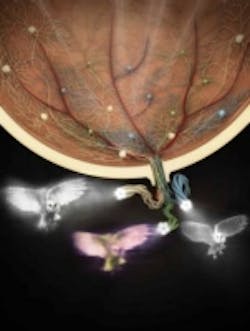Researchers show that image interpretation begins in retina
By performing research on mice, a team of neuroscientists from Tübingen University was able to determine thatimage processing in the eye is much more extensive than previously thought.
In 1959, a research paper published by cognition scientist Jerome Lettvin titled “What the frog’s eye tells the frog’s brain,” assumed that the eye not only sees, but also processes images before they are transmitted to the brain for further processing. This oft-quoted paper is considered a milestone, as questions raised during this time are still pursued by scientists today, according to a press release.
These questions are tackled by a Tübingen-based team of researchers led by Prof. Thomas Euler and Prof. Matthias Bethge (Werner Reichardt Centre for Integrative Neuroscience, Bernstein Center for Computational Neuroscience, and Institute for Ophthalmic Research). In order to find out what type of visual information is transmitted from the retina to the brain, the team investigated more than 11,000 individual retinal cells in mice.
Retinal ganglion cells (RGCs) from the mice were stained using electroporation, which makes whole populations of nerve cells visible. Using amicroscope, the researchers were able to observe individual cells at work in real time. The team analyzed the data using machine learning techniques to observe how different ganglion cells respond to properties of images, and send this information to the brain via different channels, each specialized in either contrast, color, direction or movement, edges, and so on. From these information channels, the brain processes our image of what the eye sees.
The team tested for the response behavior of the ganglion cells to various simple images and moving optical stimuli, and based on the functional differentiation, were able to identify up to 40 types of ganglion cells in the retina, which they suggest represents as many information channels. This number is far more than the 20 types which had been previously assumed, though the press release notes that, though the results from the mouse model cannot be applied directly to humans, the retina is similar in all mammals.
Based on these results, the team surmises that the large number of different information channels suggests that the retina does not only transform received light signals into nerve cell signals, but also interprets the signals in fundamental ways, leading them a step closer to understanding how images are interpreted in the brain.
View theTübingen University press release.
Share your vision-related news by contactingJames Carroll, Senior Web Editor, Vision Systems Design
To receive news like this in your inbox, click here.
Join ourLinkedIn group | Like us on Facebook | Follow us on Twitter
About the Author

James Carroll
Former VSD Editor James Carroll joined the team 2013. Carroll covered machine vision and imaging from numerous angles, including application stories, industry news, market updates, and new products. In addition to writing and editing articles, Carroll managed the Innovators Awards program and webcasts.
